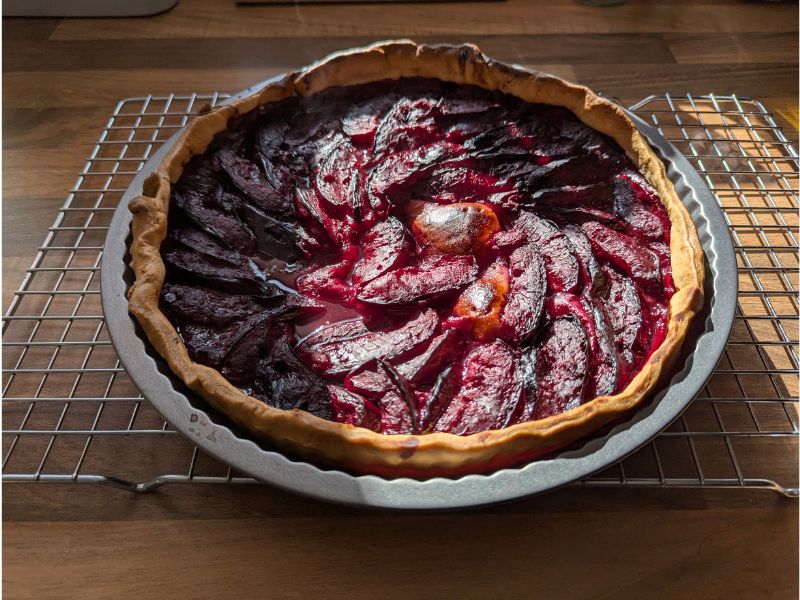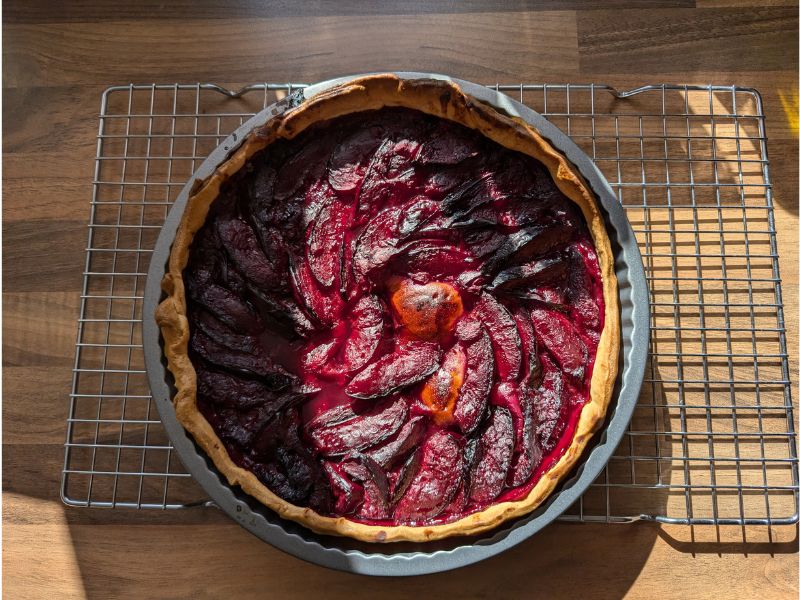When autumn graces Luxembourg, the country’s bakeries and kitchens come alive with the sweet and tangy aroma of Quetschentaart. This traditional plum tart, beloved by locals, captures the essence of the season and Luxembourg’s rich culinary heritage. Today, we’re diving into the simplicity and charm of making Quetschentaart, a delightful treat that pairs perfectly with a dollop of crème fraîche or a scoop of vanilla ice cream.
A Slice of Luxembourg’s Culinary Tradition
Quetschentaart, also known as damson tart, is a staple of Luxembourgish baking. Traditionally made with “Quetsche” (a type of damson plum), this tart is a common sight in bakeries during autumn. The unique tartness of the plums, combined with the buttery richness of the shortcrust pastry, creates a dessert that’s both comforting and refreshingly tangy.



Quetschentaart
Equipment
- 1 Tart tin
- 1 Knife and chopping board
- 1 Oven
Ingredients
- 300 g shortcrust pastry store-bought or homemade
- 600 g plums preferably damsons
Instructions
- Prepare the Pastry: Preheat your oven to 200°C (fan oven). If you’re using store-bought shortcrust pastry, roll it out and line a buttered tart tin. If you’re making your own, mix 125g of softened butter with 50g of sugar, add an egg and a pinch of salt, then sift in 250g of flour. Knead into a firm dough, wrap in cling film, and chill for 30 minutes before rolling out and lining the tart tin.300 g shortcrust pastry
- Prepare the Plums: Wash the plums, halve them, remove the stones, and cut each half into three wedges.600 g plums
- Arrange the Plums: Prick the pastry base with a fork to prevent it from rising. Arrange the plum wedges in circles on the tart base, slightly overlapping them. If you prefer a slightly sweeter tart, you can sprinkle a little sugar over the plums to take the edge off the tartness.600 g plums, 300 g shortcrust pastry
- Bake: Place the tart in the preheated oven and bake for 40 minutes. Check the tart halfway through to ensure the base isn’t puffing up. If it is, gently press it down with a fork. Note that the bottom of the tart may be slightly soggy due to the juicy plums, which is perfectly normal.
- Cool and Serve: Allow the tart to cool slightly before removing it from the tin. Serve warm or at room temperature, ideally with a generous helping of crème fraîche or vanilla ice cream to balance the tartness of the plums.
My Quetschentaart Experience




Making Quetschentaart was a delightful journey. The simplicity of the recipe highlights the natural flavours of the plums, which become wonderfully juicy and slightly caramelised in the oven. Here’s how my baking adventure unfolded:
Preparation and Baking: After rolling out the shortcrust pastry and lining my tart tin, I pricked the base with a fork—a crucial step to prevent it from rising too much during baking. Despite my efforts, the base still puffed up slightly, so be sure to prick it thoroughly. The plums, arranged in a beautiful circular pattern, retained their shape well and looked incredibly inviting as they emerged from the oven.
Tasting: The first slice revealed a tart that was juicy yet slightly soggy—a common characteristic due to the natural juices of the plums. The tartness of the plums was pronounced, making it a perfect candidate for pairing with something creamy. A spoonful of crème fraîche worked wonders in neutralising the acidity, enhancing the overall flavour experience.
Impressions: The Quetschentaart was a hit! The tartness of the plums combined with the buttery pastry created a balanced dessert that was both refreshing and comforting. It’s definitely a dish to be enjoyed in the late summer and autumn months, capturing the essence of the season.
Enjoying Quetschentaart
Quetschentaart is more than just a dessert; it’s a taste of Luxembourg’s cultural and culinary heritage. Whether you’re exploring Luxembourg’s bakeries or baking this tart at home, you’re sure to appreciate the simple yet sophisticated flavours that make it a beloved autumn treat.
So, next time you find yourself in Luxembourg during autumn, don’t miss the chance to try Quetschentaart. And if you’re far from Luxembourg, bring a slice of this delightful tradition to your kitchen. Happy baking!

Leave a Reply